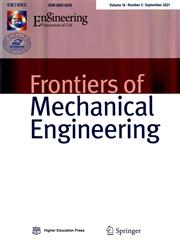海底圆锥贯入试验系统恒速贯入机理分析研究
IF 4
2区 工程技术
Q1 ENGINEERING, MECHANICAL
引用次数: 0
摘要
海底圆锥贯入试验(CPT)系统是研究近海土壤的常用方法。本文重点研究了一种新的海底CPT方法,用于评估海洋沉积物的物理力学性质。这种新方法能够在水下自动对接和拆卸探测棒。恒速穿透机制是海底CPT的基础和核心部件,允许探杆和探锥穿透海底沉积物。双液压缸用于满足高穿透力的要求。为了保持20±5 mm/s的恒定渗透率,使用Simcenter AMESim和MATLAB软件对电液伺服系统进行了模型识别,并使用PID方法获得了相关的传递函数。基于该传递函数,设计了电液伺服系统的滑模变结构控制器,以调节液压缸在不同穿透阻力下的恒定穿透率。在舟山岛使用新型海底CPT钻机进行了现场测量。仿真和测试结果表明,该滑模变结构控制器适用于实际运行中的系统控制。本文章由计算机程序翻译,如有差异,请以英文原文为准。
Analysis and research on the constant-rate penetration mechanism of the seabed cone penetration test system
The seabed Cone Penetration Test (CPT) system is a common method for investigating offshore soil. This paper focuses on a new subsea CPT method for assessing physical and mechanical properties of marine sediments. The new method enables automatic docking and dismantling of the probe rods underwater. The constant-rate penetration mechanism is the basis and core component of the seabed CPT, allowing the probe rod and cone to penetrate the seafloor sediment. Double hydraulic cylinders are used to meet the high penetration force requirements. To maintain a constant penetration rate of 20 ± 5 mm/s, the model identification of the electro-hydraulic servo system is performed using Simcenter AMESim and MATLAB software, and the relevant transfer function is obtained using the PID method. Based on this transfer function, the sliding mode variable structure controller of the electro-hydraulic servo system is designed to regulate the constant penetration rate of the hydraulic cylinder against varying penetration resistance. In-situ measurements were operated using the new seabed CPT rig in Zhoushan Island. The simulation and testing results confirm that the sliding mode variable structure controller is suitable for controlling the system during actual operation.
求助全文
通过发布文献求助,成功后即可免费获取论文全文。
去求助
来源期刊

Frontiers of Mechanical Engineering
Engineering-Mechanical Engineering
CiteScore
7.20
自引率
6.70%
发文量
731
期刊介绍:
Frontiers of Mechanical Engineering is an international peer-reviewed academic journal sponsored by the Ministry of Education of China. The journal seeks to provide a forum for a broad blend of high-quality academic papers in order to promote rapid communication and exchange between researchers, scientists, and engineers in the field of mechanical engineering. The journal publishes original research articles, review articles and feature articles.
 求助内容:
求助内容: 应助结果提醒方式:
应助结果提醒方式:


